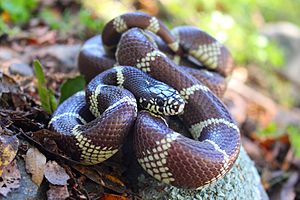California kingsnake facts for kids
Quick facts for kids California kingsnake |
|
|---|---|
 |
|
| Scientific classification | |
| Genus: |
Lampropeltis
|
| Species: |
californiae
|
| Synonyms | |
|
|
The California kingsnake (Lampropeltis californiae) is a type of snake that does not have venom. It lives only in the western United States and northern Mexico. You can find these snakes in many different places.
Many people like to keep California kingsnakes as pets. This is because they are easy to care for. They also come in many beautiful colors and patterns. Most California kingsnakes are about two feet long. But some can grow to be more than three and a half feet! They usually have stripes that are brown or black, and white or tan.
Contents
Where They Live
California kingsnakes live all along the West Coast of North America. You can find them high up in mountains, sometimes over 7,000 ft (2,100 m) tall. They like many different homes, such as forests, grasslands, deserts, and even areas where people live.
These snakes are found in Oregon, California, Nevada, Utah, Arizona, southwestern Colorado, northwestern New Mexico, and northwestern Mexico. Sometimes, in Arizona, they mix with other types of kingsnakes. These include the desert kingsnake and the Mexican black kingsnake. California kingsnakes have also been found on the Spanish island of Gran Canaria, where they are not native.
How They Act and What They Eat
California kingsnakes are usually active during the day. But if the weather gets very hot, they might come out more at night. In winter, they go underground. They enter a deep sleep called brumation, which is like hibernation.
When a California kingsnake feels scared, it will often coil up. This hides its head. It might also hiss and shake its tail. This tail shaking can sound a bit like a rattlesnake. If they are very nervous, their tails might twitch. These snakes are not harmful to humans. But if you try to pick one up, it might bite you. They can also release a smelly liquid or poop from their bodies.
How Kingsnakes "Smell"
California kingsnakes have a special way to "smell" their surroundings. They do not use their nostrils like we do. Instead, they have a forked tongue and a special organ called a Jacobson's organ.
- Their forked tongue picks up tiny scent particles from the air.
- Then, the snake puts these particles onto the roof of its mouth.
- This is where the Jacobson's organ is.
- This organ helps the snake understand what is around it through smells.
- This special sense helps them hunt for food.
What Kingsnakes Eat
California kingsnakes eat many different things. They are not picky eaters! Their meals often include rodents, birds, other reptiles, and amphibians.
All kingsnakes are not venomous. Instead, they are very strong constrictors. This means they squeeze their prey tightly until it cannot breathe. The "king" in their name comes from their habit of hunting and eating other snakes. This includes venomous rattlesnakes that live in the same areas. California kingsnakes are somewhat resistant to rattlesnake venom. But they are not completely immune. Sometimes, kingsnakes even swallow their own shed skin!
Studies have shown that California kingsnakes have a very powerful squeeze. It is one of the strongest for their body size among all snakes. This squeeze is even stronger than some much larger snakes. This strong squeeze might help them hunt other reptiles. Reptiles can survive longer without oxygen than mammals.
How They Have Babies
California kingsnakes lay eggs. This is different from some snakes that give live birth. Their mating season starts in the spring. This is usually after their winter sleep or after they shed their skin for the first time.
When two male kingsnakes fight for a female, they try to show who is stronger. One male will get on top of the other and try to bite it. The mating ritual starts with the male snake vibrating a lot.
- Females lay eggs between May and August.
- This is usually 42 to 63 days after mating.
- Before laying eggs, the female finds a good spot.
- A typical group of eggs, called a clutch, has five to 12 eggs.
- The average is nine eggs.
- Sometimes, a female can lay 20 or more eggs!
- The baby snakes hatch about 40 to 65 days later.
- They are usually about eight to 13 inches long when they hatch.
- Adult California kingsnakes are most often 2.5 to 3.5 feet long. They rarely grow longer than four feet.
As Pets
The California kingsnake is a very popular pet snake. People like them because they are easy to care for. They also look nice and are usually calm.
Because these snakes have many natural colors and patterns, people have bred them to create even more types. There are dozens of different color patterns, called "morphs," sold as pets.
It is usually against the law to sell wild California kingsnakes in their home state of California without special permits. This is because of a law that stops people from selling native California animals within the state. However, snakes that were born and raised as pets are usually allowed to be sold. So, this law is not always strictly enforced.
Currently, the California kingsnake is not considered to be in danger. But because they are so popular as pets, they have faced some challenges in the past.
Images for kids
-
This is a striped California kingsnake. You can find this type in San Diego County.
See also
 In Spanish: Serpiente real de California para niños
In Spanish: Serpiente real de California para niños


